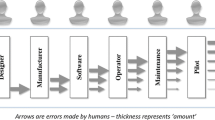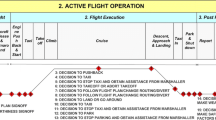Abstract
Current flight deck automation has improved the safety and efficiency of commercial aviation but a broad consensus has developed over the last 20 years that this technology is deficient in some areas. It has been developed in an ad hoc manner and without a human centered approach; leading to problems regarding the human/machine interaction and adversely impacting decision making throughout the flight. Current procedures and design do not give automation liability although it has great authority and autonomy during most phases of flight. Cockpit automation has not been designed in such a way to provide adequate and unambiguous feedback to the human operator as to its current and intended actions. More or different training is the most common response to this problem but has failed to fully compensate for the design flaws in current automated systems. Accidents that cite pilot error do not always acknowledge how difficult it is for human operators to overcome fundamental, system level, flaws in the design of the machines they work with. This paper proposes some changes in cockpit automation design that will improve the vigilance of the pilots and therefore create better decision-making. Numerous accident and incident reports have been cited by regulatory authorities when making changes in automated flight operation regulations. This reflects a “reactive” approach to FAA automated flight safety guidelines and highlights the need for an improved governance system in the cockpit. This paper also provides a literature review for current studies on human-machine interaction related to the cockpit.
Access this chapter
Tax calculation will be finalised at checkout
Purchases are for personal use only
Similar content being viewed by others
References
Edwards, E.: Automation in civil transport aircraft. Applied Ergon. 8, 194–198 (1977)
Smith, T.F., Waterman, M.S.: Identification of common molecular subsequences. J. Mol. Biol. 147, 195–197 (1981)
Leadership Under Challenge: Information Technology R&D in a Competitive World. President’s Council of Advisors on Science and Technology, Aug 2007
Degani, A., Wiener, E.L.: Procedures in complex systems: the airline cockpit. In: IEEE Transactions on Systems, Man and Cybernetics, SMC-27, pp. 302–312 (1997)
Sarter, N.B., Woods, D.D., Billings, C.E.: Automation surprises. In: Salvendy, G. (ed.) Handbook of Human Factors & Ergonomics, 2nd edn, pp. 1926–1943. Wiley, New York (1997)
Manningham, D.: The cockpit: a brief history. Bus Commercial Aviat. 80, 56–59 (1997)
Peck, W.R.: Forgotten air pioneers: the army’s rockwell field at north island. J. San Diego Hist. 101–130 (2006). Retrieved from www.sandiegohistory.org
Baltazar, L.: Airmail comes of age (2013). Retrieved from www.faa.gov, http://www.faa.gov/about/history/milestones/media/Airmail_Comes_of_Age.pdf
A brief history of the FAA [Fact sheet] (2015). Retrieved from https://www.faa.gov/about/history/brief_history/
Cong. Rec. 1705 (1978, October 24)
Aeronautical Decision Making [Advisory Circular] (1991). Retrieved from http://www.faa.gov/documentLibrary/media/Advisory_Circular/AC_60-22.pdf
Noyes, J.: Automation and decision making. In: Cook, M.J., Noyes, J.M., Masakowski, Y. (eds.) Decision Making in Complex Systems, pp. 73–82. Ashgate, Burlington, VT (2007)
Boeing. (n.d.). The glass cockpit. Retrieved from http://www.boeing.com/boeing/commercial/history/future_of_flight/glass_cockpit.page
Miller, S.: Contribution of flight systems to performance-based navigation (2009). Retrieved from www.boeing.com, http://www.boeing.com/commercial/aeromagazine/articles/qtr_02_09/pdfs/AERO_Q209_article05.pdf
Helmreich, R.L., Merritt, A.C., Wilhelm, J.A.: The evolution of crew resource management training in commercial aviation. Int. J. Aviat. Psychol. 9(1), 19–32 (1999). Retrieved from www.raes-hfg.com
Operational use of flight path management systems (2013). Retrieved from www.faa.gov, http://www.faa.gov/about/office_org/headquarters_offices/avs/offices/afs/afs400/parc/parc_reco/media/2013/130908_PARC_FltDAWG_Final_Report_Recommendations.pdf
Chialastri, A.: Automation in aviation. In: Kongoli, F. (ed.) Automation, pp. 79–102. InTech, Rijeka, Croatia (2012)
Degani, A., Shafto, M., Kirlk, A.: Modes in automated cockpits: problems, data analysis, and modeling framework (1996). Retrieved from http://ti.arc.nasa.gov/, http://ti.arc.nasa.gov/m/profile/adegani/Modes%20in%20Automated%20Cockpits.pdf
Casner, S.M., Geven, R.W., Recker, M.P., Schooler, J.W.: The retention of manual flying skills in the automated cockpit. Hum. Factors 56, 1506–1516 (2014). Retrieved from https://labs.psych.ucsb.edu/schooler/jonathan/sites/labs.psych.ucsb.edu.schooler.jonathan/files/biblio/2014%20The%20Retention%20of%20Manual%20Flying%20Skills%20in%20the%20Automated%20Cockpit.pdf
Geiselman, E.E., Johnson, C.M., Buck, D.R.: Flight deck automation: invaluable collaborator or insidious enabler? Ergon. Des. 22–26 (2013)
Reidemar, H.: Philosophy and policies of automation: an operational perspective (2012). Retrieved from http://safetyforum.alpa.org, http://safetyforum.alpa.org/LinkClick.aspx?fileticket=nsto2LOYlRQ%3D&tabid=2275
Harris, D.: Human Performance on the Flight Deck. Ashgate Publishing Company, Burlington, VT (2011)
Boy, G.A.: The Handbook of Human-Machine Interaction: Human-Centered Design Approach. Ashgate, Burlington, VT (2011)
Author information
Authors and Affiliations
Corresponding author
Editor information
Editors and Affiliations
Rights and permissions
Copyright information
© 2017 Springer International Publishing Switzerland
About this paper
Cite this paper
Taylor, A. (2017). Human-Machine Interaction in the Cockpit and Applicable Design Changes Towards Better Collaboration. In: Nunes, I. (eds) Advances in Human Factors and System Interactions. Advances in Intelligent Systems and Computing, vol 497. Springer, Cham. https://doi.org/10.1007/978-3-319-41956-5_24
Download citation
DOI: https://doi.org/10.1007/978-3-319-41956-5_24
Published:
Publisher Name: Springer, Cham
Print ISBN: 978-3-319-41955-8
Online ISBN: 978-3-319-41956-5
eBook Packages: EngineeringEngineering (R0)




